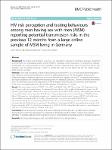HIV risk perception and testing behaviours among men having sex with men (MSM) reporting potential transmission risks in the previous 12 months from a large online sample of MSM living in Germany
Marcus, Ulrich
Gassowski, Martyna
Drewes, Jochen
Background: HIV testing and serostatus awareness are essential to implement biomedical strategies (treatment as prevention; oral chemoprophylaxis), and for effective serostatus-based behaviours (HIV serosorting; strategic positioning). The analysis focuses on the associations between reported sexual risks, the perceived risk for HIV infection, and HIV testing behaviour in order to identify the most relevant barriers for HIV test uptake among MSM living in Germany. Methods: MSM were recruited to a nationwide anonymous online-survey in 2013 on MSM social networking/dating sites. Questions covered testing behaviours, reasons for testing decisions, and HIV risk perception (5-point scale). Additional questions addressed arguments in favour of home/ home collection testing (HT). Using descriptive statistics and logistic regression we compared men reporting recent HIV testing (RT; previous 12 month) with men never tested (NT) in a subsample not previously diagnosed with HIV and reporting ≥2 episodes of condomless anal intercourse (CLAI) with a non-steady partner of unknown HIV serostatus in the previous 12 months. Results: The subsample consisted of 775 RT (13 % of RT) and 396 NT (7 % of NT). The number of CLAI episodes in the last 12 months with non-steady partners of unknown HIV status did not differ significantly between the groups, but RT reported significantly higher numbers of partners (>5 AI partners: 65 vs. 44 %). While perceived risks regarding last AI were comparable between the groups, 49vs. 30 % NT were
Dateien zu dieser Publikation
Keine Lizenzangabe

